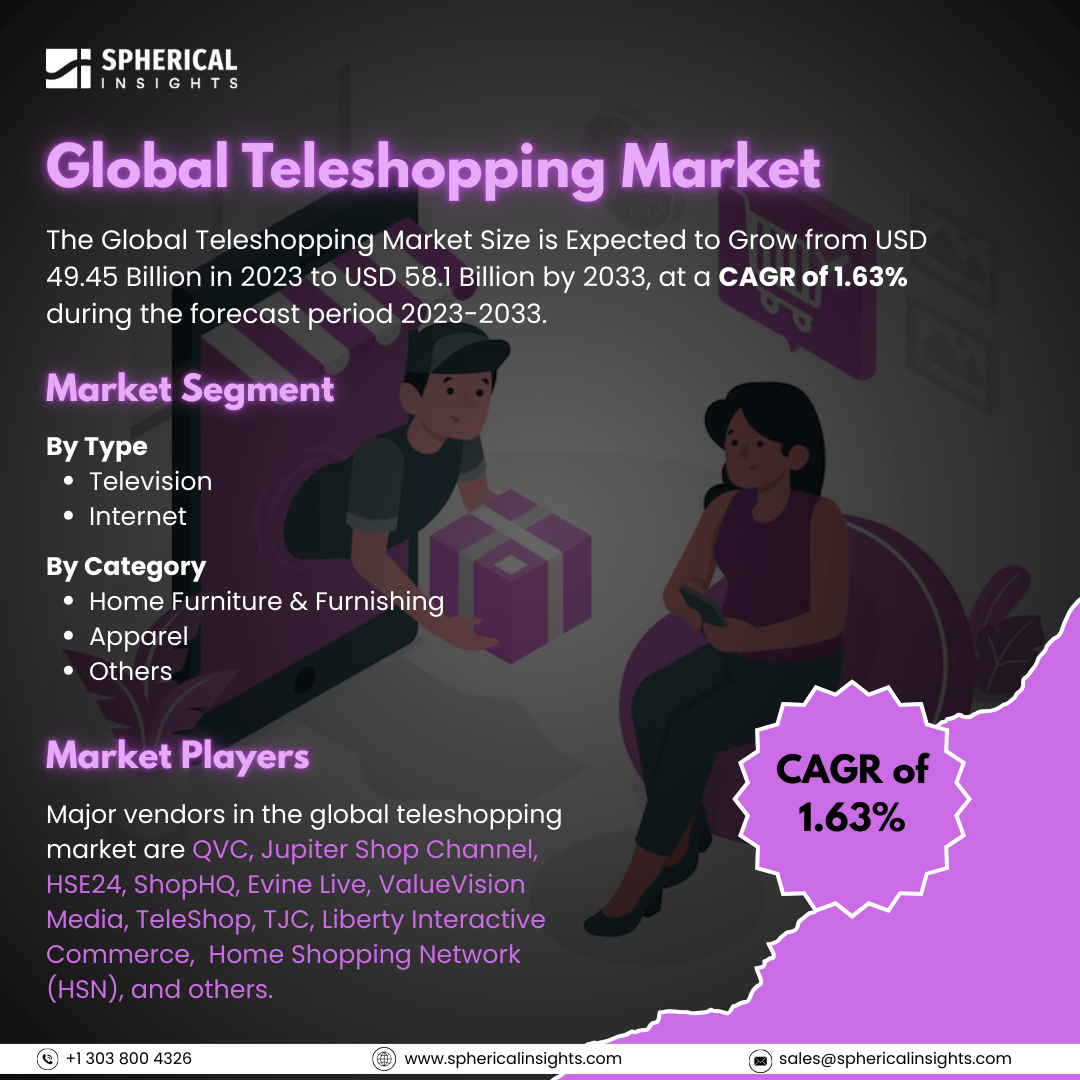Global Teleshopping Market Size to Exceed USD 58.1 Billion by 2033
According to a research report published by Spherical Insights & Consulting, The Global Teleshopping Market Size is Expected to Grow from USD 49.45 Billion in 2023 to USD 58.1 Billion by 2033, at a CAGR of 1.63% during the forecast period 2023-2033.
Browse 210 market data Tables and 45 Figures spread through 190 Pages and in-depth TOC on the Global Teleshopping Market Size, Share, and COVID-19 Impact Analysis, By Type (Television and Internet), By Category (Home Furniture & Furnishing, Apparel, and Others), and By Region (North America, Europe, Asia-Pacific, Latin America, Middle East, and Africa), Analysis and Forecast 2023 – 2033
A subset of the retail sector known as "teleshopping" involves the sale of goods and services via television networks. In order to present and promote products, this marketing strategy uses infomercials, advertisements, or special shopping programs. In the near future, teleshopping is expected to rise significantly due to a variety of variables. The demand for these services has increased as a result of consumers' growing reliance on convenience and remote shopping. The market is seeing an increase in demand for a wide variety of products made available through platforms as consumers continue to appreciate hassle-free and time-saving shopping experiences. Furthermore, the growing popularity of Internet shopping and the availability of a large selection of products through televised shopping programs drive market expansion by providing customers with convenient and affordable shopping options. Additionally, the teleshopping scene is significantly shaped by technical improvements. In order to maximize the customer experience, businesses are investing in state-of-the-art technology and intuitive user interfaces. Innovative strategies include enhanced broadcasting methods and interactive elements to raise the programs' allure and level of involvement. Additionally, the industry's move toward sustainable practices like eco-friendly packaging and less environmental effect during shipping aligns with the interests of customers who care about the environment. The market is growing as a result of this ideal fusion of changing consumer behaviour and technology advancements. However, the intricate logistical difficulties involved in shipping and delivery are a major deterrent to the teleshopping industry.
The television segment held the highest share in 2023 and is anticipated to grow at a significant CAGR during the projected timeframe.
Based on type, the global teleshopping market is categorized as television and internet. Among these, the television segment held the highest share in 2023 and is anticipated to grow at a significant CAGR during the projected timeframe. Its extensive use in home solar installations is primarily responsible for its domination. Shopping channels that are shown on television are included in the television sector. Customers can order things online or by phoning a toll-free number.
The home furniture & furnishing segment held the highest share in 2023 and is anticipated to grow at a significant CAGR during the projected timeframe.
Based on the category, the global teleshopping market is categorized as home furniture & furnishing, apparel, and others. Among these, the home furniture & furnishing segment held the highest share in 2023 and is anticipated to grow at a significant CAGR during the projected timeframe. Teleshopping provides customers with an easy and convenient option to purchase furniture and furnishings for their homes in a time when convenience is highly prized. Viewers no longer need to travel to actual businesses or showrooms because they may peruse a variety of selections from the convenience of their homes.
Asia Pacific is projected to hold the largest share of the global teleshopping market over the forecast period.
Asia Pacific is projected to hold the largest share of the global teleshopping market over the forecast period. The people in the area are tech-savvy and quick to adopt new digital solutions. In order to assist the expansion of e-commerce and platforms, governments in nations like China, Japan, and South Korea have promoted digital infrastructure. Additionally, the move to online buying has been made easier by the growing middle class and increased internet access, which has greatly aided Asia-Pacific's market domination.
North America is expected to grow at the fastest CAGR growth of the global teleshopping market during the forecast period. The economies of North America, which includes the United States and Canada, are among the biggest in the world. Because of its high degree of consumer buying power and disposable income, the area is a desirable market for teleshopping businesses. For teleshopping operators, North American consumers represent a valuable target market since they are eager to spend money on a variety of goods and services.
Company Profiling
Major vendors in the global teleshopping market are QVC, Jupiter Shop Channel, HSE24, ShopHQ, Evine Live, ValueVision Media, TeleShop, TJC, Liberty Interactive Commerce, Home Shopping Network (HSN), and others.
Key Target Audience
- Market Players
- Investors
- End-users
- Government Authorities
- Consulting and Research Firm
- Venture capitalists
- Value-Added Resellers (VARs)
Market Segment
This study forecasts revenue at global, regional, and country levels from 2020 to 2033. Spherical Insights has segmented the global teleshopping market based on the below-mentioned segments:
Global Teleshopping Market, By Type
Global Teleshopping Market, By Category
- Home Furniture & Furnishing
- Apparel
- Others
Global Teleshopping Market, By Regional
- North America
- Europe
- Germany
- UK
- France
- Italy
- Spain
- Russia
- Rest of Europe
- Asia Pacific
- China
- Japan
- India
- South Korea
- Australia
- Rest of Asia Pacific
- South America
- Brazil
- Argentina
- Rest of South America
- Middle East & Africa
- UAE
- Saudi Arabia
- Qatar
- South Africa
- Rest of the Middle East & Africa



